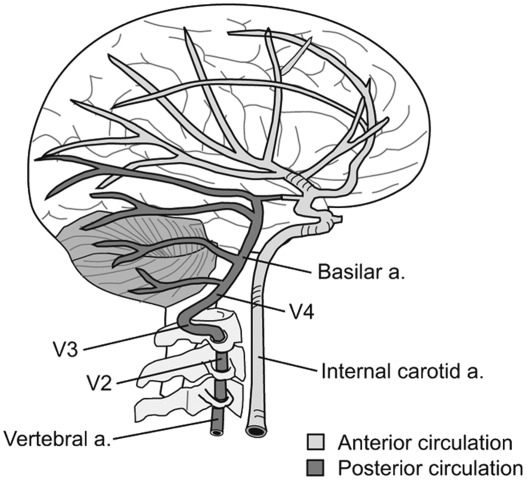Chiropractic Management of Neck Pain Complicated by Symptomatic Vertebral Artery Stenosis and Dizziness
SOURCE: American Journal of Case Reports (Sep 14) 2022 [Epub]
| OPEN ACCESS |
Eric Chun-Pu Chu, Robert J. Trager, Cliff Tao, Linda Yin-King Lee
New York Chiropractic and Physiotherapy Centre,
EC Healthcare,
Kowloon, Hong Kong

BACKGROUND Vertebrobasilar insufficiency (VBI) is most often caused by vertebrobasilar atherosclerosis, often presenting with dizziness and occasionally neck pain. Little research or guidelines regarding management of neck pain in affected patients exists.
CASE REPORT A 62–year-old male hypertensive smoker presented to a chiropractor with a 13–year history of insidious-onset neck pain, dizziness, and occipital headache with a Dizziness Handicap Inventory (DHI) of 52%. The patient had known VBI, caused by bilateral vertebral artery plaques, and cervical spondylosis, and was treated with multiple cardiovascular medications. The chiropractor referred patient to a neurosurgeon, who cleared him to receive manual therapies provided manual-thrust cervical spinal manipulative therapy (SMT) was not performed. The chiropractor administered thoracic SMT and cervicothoracic soft tissue manipulation. The neck pain and dizziness mostly resolved by 1 month. At 1–year follow-up, DHI was 0%; at 2 years it was 8%. A literature search revealed 4 cases in which a chiropractor used manual therapies for a patient with VBI. Including the present case, all patients had neck pain, 60% had dizziness, and all were treated with SMT either avoiding manual cervical manipulation altogether or modifying it to avoid or limit cervical rotation, yielding positive outcomes.
There are more articles like this @ our:
STROKE AND CHIROPRACTIC Section
CONCLUSIONS The present and previous cases provide limited evidence that some carefully considered chiropractic manual therapies can afford patients with VBI relief from concurrent neck pain and possibly dizziness. Given the paucity of research, cervical SMT cannot be recommended in such patients. These findings do not apply to vertebral artery dissection, for which SMT is an absolute contraindication.
KEYWORDS:   Chiropractic; Dizziness; Headache; Manipulation, Spinal; Neck Pain; Vertebral Artery
From the FULL TEXT Article:
Background
Vertebrobasilar insufficiency (VBI), also called posterior circulation insufficiency or vertebrobasilar transient ischemic attack, is defined as a transitory ischemia of the vertebrobasilar circulation [1–3] and is a risk factor for vertebrobasilar stroke. [4, 5]
VBI is most often caused by atherosclerotic vertebral or basilar artery stenosis and can also result from vertebral artery hypoplasia, rotational vertebral artery occlusion, vertebral artery dissection, coagulopathy, drug abuse, or migraine. [1, 6–9] VBI related
to atherosclerosis typically presents as dizziness, visual dysfunction, or cognitive dysfunction [10], and occasionally presents with posterior neck pain. [11] However, there is little research on how to best manage neck pain in patients with comorbid VBI





Leave A Comment